Part 3: München
Exchanging pizza, chianti and relative warmth (>0ºC) for schweinshax'n, pilsener and freezingness, we alighted at Munich Flughafen & trained past snow-covered fields in to town.

Walked from our hostel (Wombat Hostel - really good and value => recommended), near the Hauptbahnhof, into the town centre and had a look around. Dined at Nordsee at the Viktualienmarket, after an entree of Schwarzwaldtorte-style doughnut (yes, it is as good as it sounds, cherries, cream, chocolate sprinkles - Krispy Kreme eat your heart out).

Had an obligatory beer at the Hofbrauhaus,
 and called it a night at a relatively early hour in preparation for the forthcoming cultural blitzkrieg.
and called it a night at a relatively early hour in preparation for the forthcoming cultural blitzkrieg.
_____________________________________________________________
The following morning we strolled north to the area of town where most of the museums are located. Being the centre of the relatively prosperous and powerful Kingdom of Bavaria until the unification of Germany, Munich has some of the trappings of a capital: impressive large buildings laid out nicely amongst big gardens & open spaces.

Here we are in front of the Glypothek (sculpture museum):

which we admired from outside only, before heading to the Staatsgalerie im Lenbachhaus:

The highlights here were the works of Der Blaue Reiter: Kandinsky, Munter, Jawlensky, Marc, Macke et al, who lived and worked in Munich and surrounding towns in the early 1900s, and who did amazing things firstly with colour, and later with form.

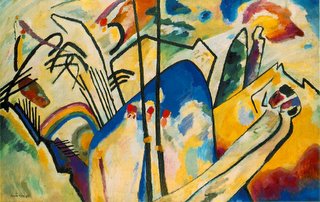
The Munchener symbolist, Franz von Stuck, was pretty cool too (if a bit naughty... tee hee):
 Walked east to the Englischergarten, so named after Sir Benjamin Thompson, aka Count Rumford, the American-born British-aligned (during the American revolution) thermodynamicist and emissary to the Elector of Bavaria, who laid out the plans for them.
Walked east to the Englischergarten, so named after Sir Benjamin Thompson, aka Count Rumford, the American-born British-aligned (during the American revolution) thermodynamicist and emissary to the Elector of Bavaria, who laid out the plans for them.


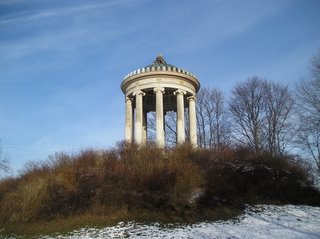 Headed into town for a lunch of Bismarck herring sandwiches and giant pickled gherkins (one of the few vegetables available in Germany),
Headed into town for a lunch of Bismarck herring sandwiches and giant pickled gherkins (one of the few vegetables available in Germany),

checked out the Rathaus by day,
 then off to the Alte Pinakothek, for a hearty dose of meisterwerke europäischer malerei vom 14 bis 18 jahrhundert.
then off to the Alte Pinakothek, for a hearty dose of meisterwerke europäischer malerei vom 14 bis 18 jahrhundert.

We were a bit time constrained but managed to zip through most of the galleries, checking out the masses of Cranachs, Holbeins, Memlings, Durers - lots of northern renaissance art to complement that from south of the alps we'd enjoyed in Italia. The big highlight was definitely the collection of Rubens, including the whoppingest painting of his that i've ever seen: the Great Last Judgement (about 6 metres tall, the jpeg here doesn't do it justice.)
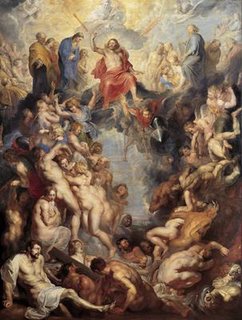
Booted out at closing, but artistically unsated, we marched purposefully across the road, impervious to the bitter cold,

to the Pinakothek der Moderne, where after a rejuvanatory round of Ein caffe bitte,

we had a lookee at the amazing collection of modern art ranging from sculpture & paintings (Die Brucke & Der Blaue Reiter), to craft & design, to installations & video works.




Of particular note, there was a really cool video collage of the movies of Italian film-maker Piero Paolo Pasolini. One sat in the centre of the room and segments of the films were projected onto 16 screens around the walls. Parallel scenes from different movies were shown together, eg. a woman walking along a street, people starting to hold hands, people dancing etc. At other times, the scenes differed but complemented one another despite obviously being from different movies. At times there were up to 8 different scenes at once - it was redolent of Baraka or Koyanoqaatsi in the cacophony of images, but a spectacular illustration of how he returned to the same basic themes and employed consistent images throughout his career - it would have been pretty fun to produce the collage.
 All this art had given us mighty big appetites, appetites so large they could only be quelled with half a pig. We returned to the Hofbrauhaus, having partaken of their libational but not culinary offerings the previous night, and got stuck right in:
All this art had given us mighty big appetites, appetites so large they could only be quelled with half a pig. We returned to the Hofbrauhaus, having partaken of their libational but not culinary offerings the previous night, and got stuck right in:


The childlike joy in my face masks the screams of protest from my arteries (and liver, though it should have learnt by now that its ) as I tucked into the mighty piece-o-pig they call a schweinshax'n. Another opportunity to be embarrassed about our nationality as the oom-pah band played Waltzing Matilda and half the crowd (most of whom had ridden in to town on Kontiki buses methinks) went wild. A far cry from the dignified near-silence of the Alte Pinakothek but I suppose travel is flavoured by such contrasts.
____________________________________________________________
The next morning we headed north once again,

to complete the Pinakothek hattrick, going this time to the Neue Pinakothek to see paintings, predominantly German and predominantly from the 19th century.


Highlights were: paintings by the Nazarenes, pious Germans who lived in Rome and aimed to emulate the styles of the pre- and early renaissance masters (quite similar in ideology and style to England's own Pre-Raphaelite brotherhood),

paintings by Klenze and Schinkel, both better known for their neoclassical architecture, Klenze having designed the Glyptothek and Walhalla and Schinkel having designed the Altes Nationalgalerie in Berlin,

lavish sculptures by Canova and Thorvaldsen;
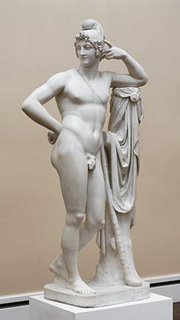
and a bit more Franz von Stuck (another risque theme, this one entitled Sin).
 The paths around the town were covered with snow and ice which, on the oft-trodden ones, was quite smooth and hard. Most fortuitously my shoes had nice, flat soles which allowed me, by taking a bit of a run-up, to "skate" along for several metres at a time (trust me i measured it). I found that bending the knees slightly and shouting "Woo-Hoo" gave the best results.
The paths around the town were covered with snow and ice which, on the oft-trodden ones, was quite smooth and hard. Most fortuitously my shoes had nice, flat soles which allowed me, by taking a bit of a run-up, to "skate" along for several metres at a time (trust me i measured it). I found that bending the knees slightly and shouting "Woo-Hoo" gave the best results.

Boy, that game never got tired. Miraculously, i didn't fall over. No photos i'm afraid as Maarinke declined to encourage such activities. The novelty of snow has definitely not worn off - 21 formative years in Western Australia has ensured that.
After a quick lunch at the Hbf, we caught the train out to Dachau for some history. It must be strange for the people in Dachau, which is a reasonable sized town half an hour's train ride from Munich, to know that their hometown is immediately associated with some of the worst atrocities of the second world war, thanks to the decision to build the first concentration camp there in 1933. The museum is set out really well, giving a lot of info on the social, economic & political background to WWII then portraying the inmates & the appalling conditions in which they lived, worked and in many cases died.


A large fraction of the prisoners at Dachau between 1933 and 1945 were ethnic Germans, predominantly political prisoners, dissidents who had opposed the Nazi regime as it came to power in the 1930s, in addition to the Jewish, Roma, homosexual and other prisoners regarded as impure under the xenophobic policies of the Nazis.

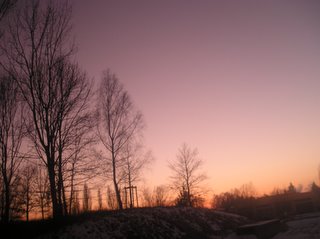
I can't say much more except that it was really worth visiting - a solemn reminder that a society as advanced as any other in the world at the time can produce such horrors.
An interesting counterpoint to the former concentration camp at Dachau was provided by a visit to Haus der Kunst, built under Hitler as a museum to display and distinguish between art approved by the Nazis and that condemned by them.
The approved stuff was a strange mix of strong images & sculptures (& buildings) and bucolic idealisations of German life, along with xenophobic depictions of the soon-to-be victims of the Holocaust. "We shall discover and encourage the artists who are able to impress upon the State of the German people the cultural stamp of the Germanic race . . . in their origin and in the picture which they present they are the expressions of the soul and the ideals of the community." (Hitler, Party Day speech, 1935). There are big similarities between the german Reich Kunst and the Socialist Realism promoted by Stalin around the same time.
The Degenerate Art condemned by them, and removed en masse from German museums, included Chagall, Beckmann, Ernst, Kandinsky, Kirchner, Klee, Mondriaan et al - basically a Who's Who of the most progressive, important and respected (now, at least) artists of the period, many of whom were German or lived in Germany. The Nazis staged exhibitions of selected "Entartete Kunst", the first of which was at the Haus der Kunst. Interestingly, over 3 million people attended these - it is hard to know what this says about the German people at the time.
One could dismiss the condemnation and ridiculing of paintings in comparison with the obvious human tragedy associated with somewhere like Dachau, but one is reminded that these were both facets of the same totalitarian regime - poignant in considering issues of censorship, freedom of speech, etc. While we can look back and scoff at the art that was 'approved', knowing that the 'degenerate' stuff was and is much better, the control of art by the state, while intellectually backward, reflected and propagated underlying political ideology that led to millions of deaths.


The building has an obvious sternness to it, in keeping with Hitler's imposing architectural ideals - art and architecture as tools for propagating ideology and gaining power and social control. The Haus der Kunst obviously isn't being used as a political tool now (except, subtly, in the sense that its very existence and its current use, exhibiting works that would no doubt have been regarded as degenerate, makes a statement), and I saw two very cool exhibitions, a retrospective of the photographs of Lee Friedlander and a collection of works by siblings in art, ranging from the Brothers Limbourg to Jake and Dinos Chapman.
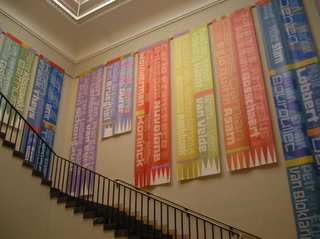

We dined at Cafe Mozart, a really funky, ostensibly-Austrian (a biiiig schnitzel for the big fatty that i'm rapidly becoming) but quite cosmopolitan restaurant (near Sendlinger Tor, for anyone that's interested). The DJ mixing jazz and soul was a welcome contrast to the tuba and accordion rendition of Waltzing Matilda of the previous night.
____________________________________________________________
Farewelling Munich after an incredible three days there, we tarried not, dashing Flughafen-ward to check in for Cologne.

My fears regarding the dubiousness of my chosen budget airline were allayed upon discovering that Munich, unlike Rome, is one of their hubs; not only was my flight not cancelled, there were actually staff from the airline there to check me in, rather than some dodgy subcontracted checking-in service, so it was all good. Bade Maarinke a temporary farewell and made a dent in my travel reading: Millenium by Felipe Fernandez Armesto, a suitably lofty tome for our ambitiously self-improving expedition.
Final reflections on Munich: beyond the hearty Bavarian pretzels/beer/oompah/leiderhosen image that is initially presented to tourists, it is a really cool, stylish city. I enjoyed strolling the streets around the north of the town, near the museums and the opera, Residenz etc. - lots of trendy boutiques, little art galleries, stately buildings full of private banks and venture capital firms - signs of a prosperity that contradicts the much-vaunted economic stagnation in Germany - this is probably being experienced most drastically in the East. Munich definitely gives Berlin a run for its money as the cultural capital of Germany, I give it two thumbs up and definitely recommend it as a place to visit - though please, if you do so as part of a Kontiki tour, please do not go to the Hofbrauhaus, get drunk and sing along to the oompah band - it doesn't benefit anybody.
Next stop: Rhineland.
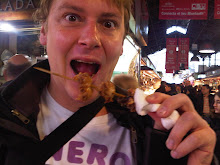

0 Comments:
Post a Comment
<< Home